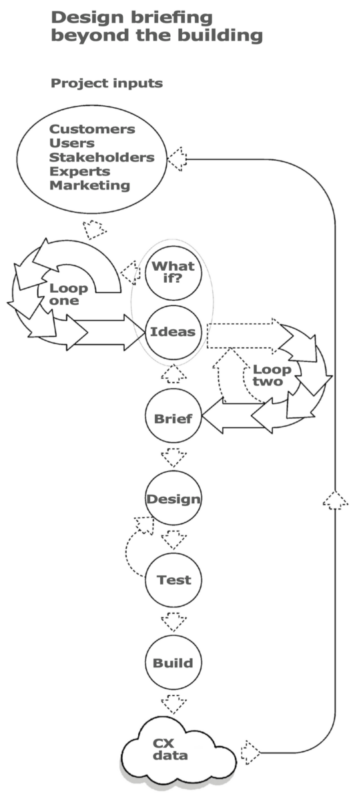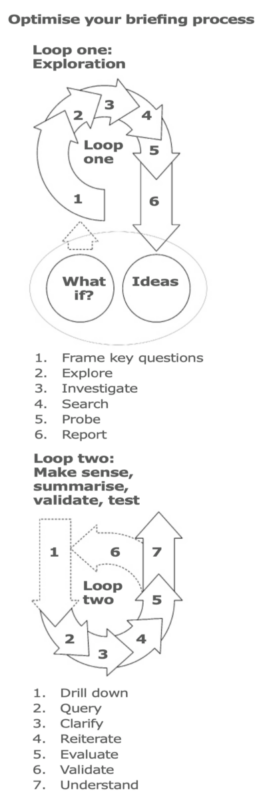Cultivate better building design briefing by creating a superior collective intelligence
Of greater consequence than its buildings – and something over which your organisation also has complete control – the most important factor you can design for its continued health and survival is the future intelligence at work within your business.
Put simply, the smarter a company gets about investigating its customers’ perceptions and experiences with its products, and reporting back to
and checking with them on what it finds, the better those products can become.
The smarter it then gets about reflecting back and translating what it has discovered with its people into the pursuit of superior processes, the smarter it can become in producing them.
To overcome challenges, it’s time to think at a different scale about competition in property’s future
 No business can afford not to be able to attract new business, and each must learn to avoid that prospect by discovering new ways to improve the customer experience (CX) it offers. The smarter and more focused it becomes about this, the faster its competitiveness and reputation is likely to accelerate.
No business can afford not to be able to attract new business, and each must learn to avoid that prospect by discovering new ways to improve the customer experience (CX) it offers. The smarter and more focused it becomes about this, the faster its competitiveness and reputation is likely to accelerate.
The fact that a growing number of Australia’s very largest developers and owners of commercial property now employ managers with “customer experience” in their job titles offers one simple indication of how, through digitisation, the marketing landscape for commercial property in Australia is evolving to bring its providers closer to customers.
Against this, in the connected, digital age, the approach we describe here to contest their advances, while unique, is also obvious and of its time.
We may still be in the earliest years of the internet, but, just as in your own company, every mind in every other business with which you compete is also now better connected than ever before.
Hence, the degree of precision with which interested minds can be steered in unison to bring to clarity of understanding to the needs and preferences of any group of building users is unprecedented.
When users’ demands of a building can become more thoroughly understood and explained, it becomes possible to brief and repeatedly test its design to meet their expectations and tastes with unparalleled accuracy.
Inevitably, out of this capability, an unexpected upstart will set a new standard for the way in which it learns to organise this intellectual force in its own business, to focus its creative collective intelligence on solving more sophisticated and clearly articulated design challenges.
The competitor best able to realise this most potent resource from within its business and customer base, guided by better data, at speed, will become the most formidable of competitors, with an enhanced capability for designing better buildings and improving every step in its customers’ experience.
Every property provider’s competitive challenge now lies in making work the readily accessible cognitive resource within every property customer’s mind and at every desk within every rival business.
But first, what is collective intelligence?
Collective intelligence itself – sometimes described as the ability to think at scale – is created when a group of diverse people work together, often with the help of technology, to mobilise a wider range of information, ideas and insights in order to solve a problem.
It presents a combination of machine intelligence – AI, data, and so on – with human sensitivities of imagination, instinct, emotion, judgement, reasoning, knowledge, experience and learning.
It’s based on the premise that intelligence is distributed, and that when people work together on a problem they can become more than the sum of their parts.
Different people each hold different pieces of information and contribute different skills that, when combined, create a more complete picture of a problem and how to solve it.
As exceptional as machines may be at the large-scale processing that can amplify certain organisational capabilities, appliances driven by machine learning still remain weak at spotting the non-obvious patterns evident to humans.
Collective intelligence’s intellectual force, therefore, results from bringing together machine-learning capabilities, data and uniquely human judgement within a “collective brain” capable of outperforming any of its individual components.
Drawing on what it knows, collective intelligence presents the capacity of groups to make progressively better decisions – to choose what to do, and with whom to do it – through a combination of human and machine capabilities.
Thus, it’s those businesses that upgrade their human capital at the same time as investing in smart AI that will get the biggest benefits from collective intelligence driven by machine learning.
We describe in the next section how you can reliably capture, design and grow your own business’s collective intelligence, and refine it repeatedly, with increasing precision, to improve the accuracy with which you address your property customers’ needs.
How a higher grade of briefing can be captured in two simple loops of examination
 With this dependable, double-loop briefing process, you can build new value from what your people and your customers know.
With this dependable, double-loop briefing process, you can build new value from what your people and your customers know.
The idea of capturing a workplace’s knowledge, let alone that of a customer base, may sound chaotic and messy, which it is. Yet, making sense from a cacophony of competing voices and opinions is no different to the challenge faced by news organisations reporting around the world every day.
As such, our solution isn’t rocket science, but a communication process proven both by our own repeated personal experience of written reporting and sense-making over many years, and by centuries of practice by others.
Its goal is to document for those involved the information they require in a consistent, reliable fashion, such that they can drill down into this resource to keep on refining their approach to getting from it what they need when they need it.
Our briefing process therefore follows the diagrams to the side, using sense-making rules that apply to all publishing of professional quality.
Loop one
Depending on the question put to it, the first loop’s aim is to fish for possibilities, ideas and insights, based on what is believed, known and experienced by the exercise’s target group.
From what members submit, at the end of this loop, a broad, outline report is generated.
Loop two
In the second loop, this report is held up for scrutiny and questions are asked to verify meaning and intention, in order to guide the development of the interrogation.
Once revealed to a group whose prior perspectives – and possibly, even its members – were previously unknown to each other, it is to elicit comment by sparking new and unexpected insights to build upon what is known collectively by its participants.
It is to summarise, and, through reiteration and clarification, create a platform for subsequent interrogation, in plain English.
In professional media production, rule number one is that every writer needs a second reader to check facts and to ensure what is written can be understood.
Unchecked, imprecisely written material, possibly in great volume, is of no help to anyone. Making complete, concise sense is critical if learning is to be focused, multi-party thought is to be scaled appropriately to meet the critical tasks at hand, and important investment decisions are to be made.
Property’s future will be built inside the minds of customers
From a “knowledge architecture” point of view, any building creates an opportunity to build a better awareness of uses and users, to develop new insights into how to satisfy its target audience’s need, and how to attract others like it.
As illustrated, “briefing beyond the building” by tapping into the available connected intellect is straightforward QA, enabling development of the most appropriate and best-fitting combinations of products and services.
We believe briefing via the internet-connected intellect has a big future because, at minimum, it simply adapts long-standing qualitative market research practices to the emerging needs and idiosyncrasies of property customers.
Now, property, like all other businesses touched by the internet, is also becoming an information business, those who use it to build their collective development intelligence well are likely also to benefit from distinctive reputational differentiation and business growth to be won against those rivals that haven’t yet even begun to figure this out.●



